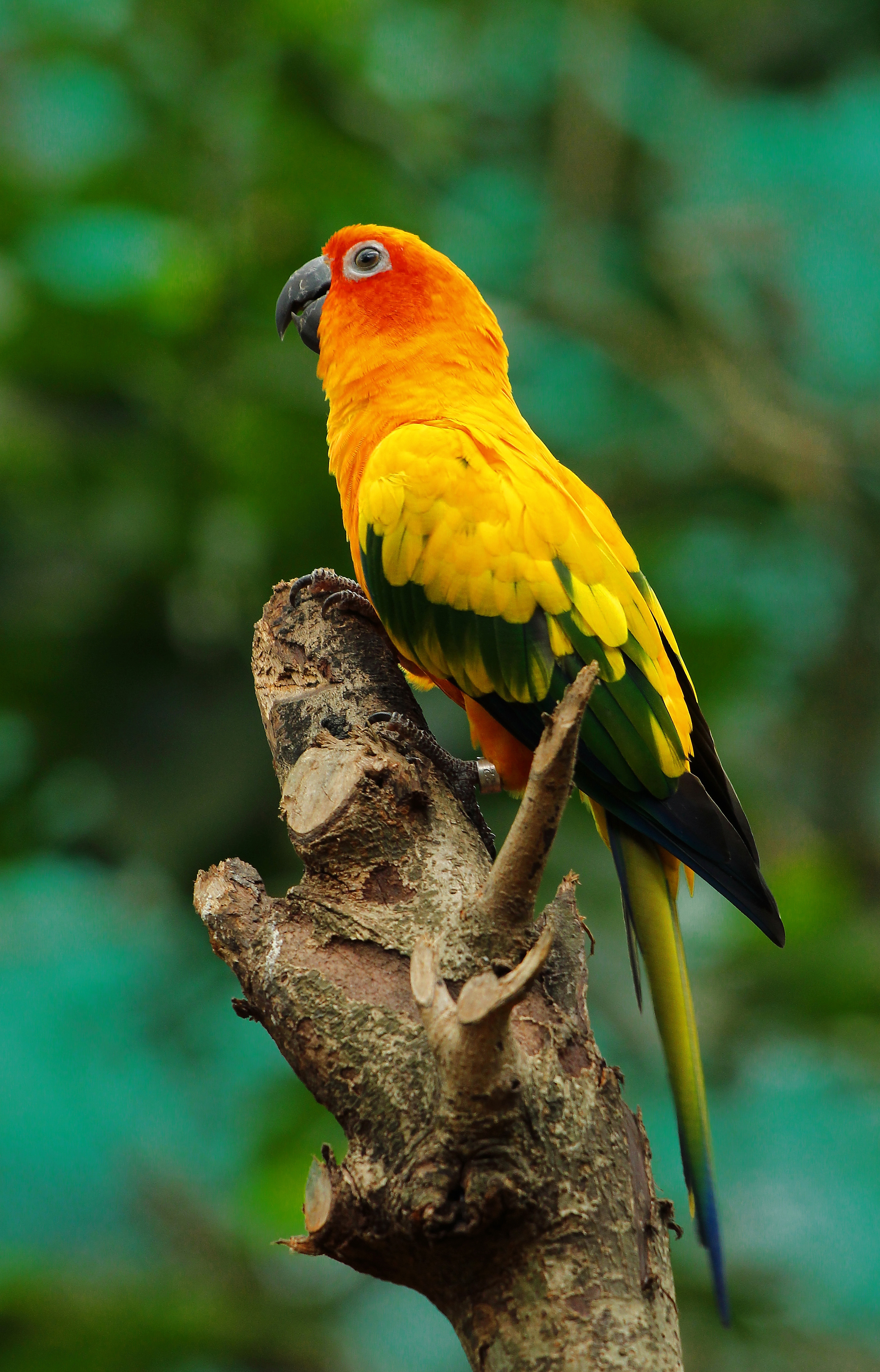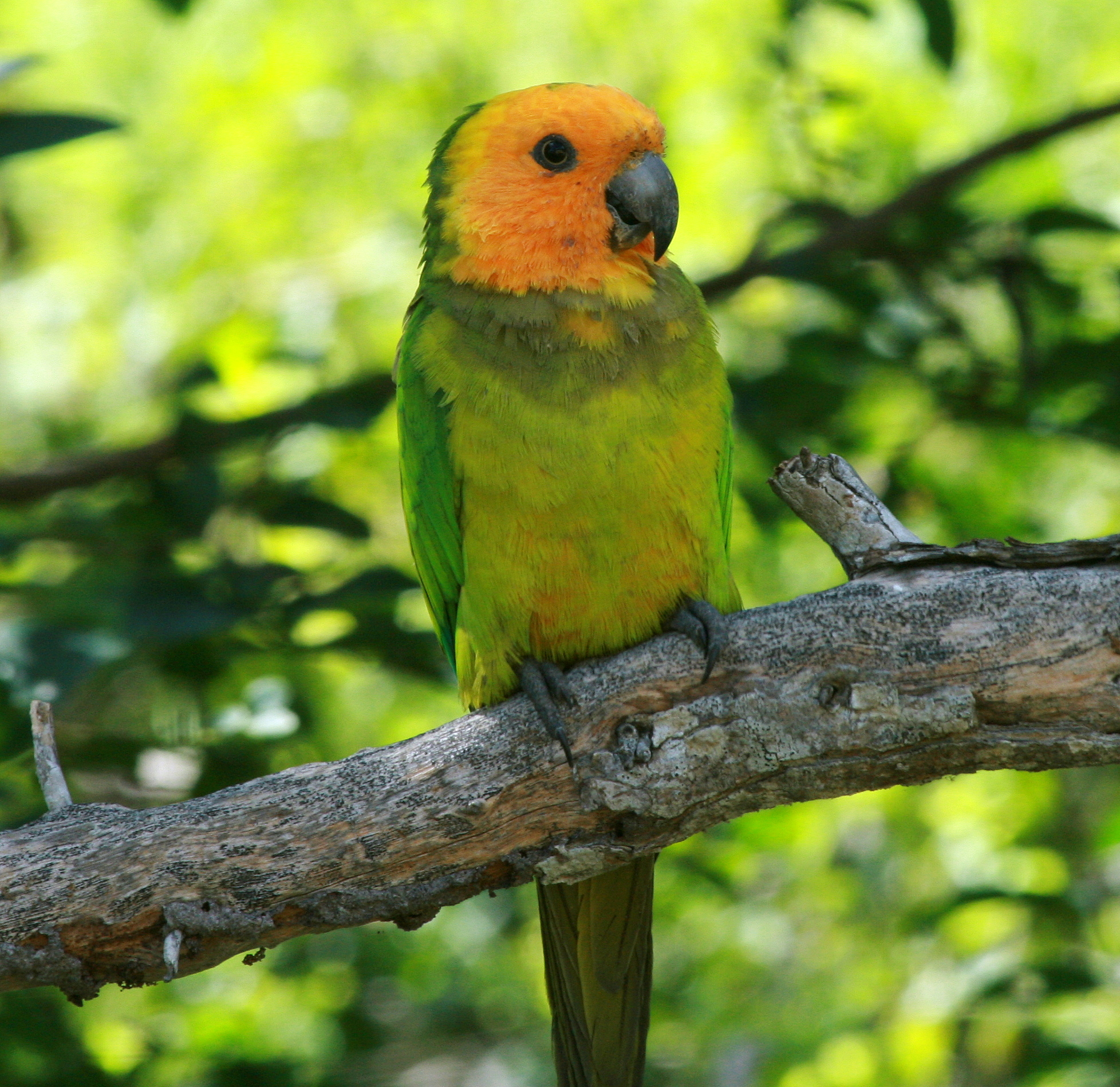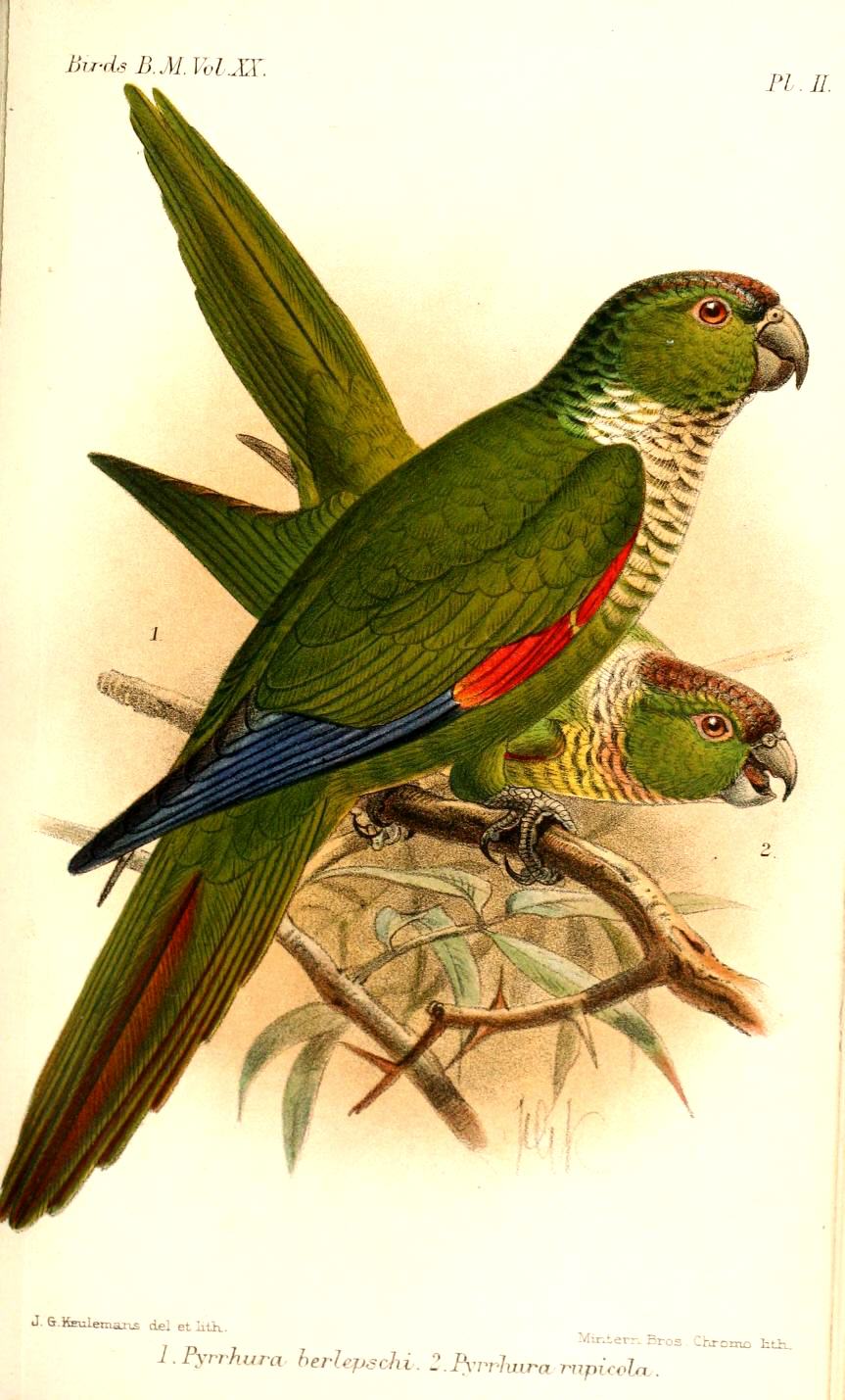|
Conure
Conures are a diverse, loosely defined group of small to medium-sized parrots. They belong to several genera within a long-tailed group of the New World parrot subfamily Arinae. The term "conure" is used primarily in bird keeping, though it has appeared in some scientific journals. The American Ornithologists' Union uses the generic term ''parakeet'' for all species elsewhere called ''conure'', though Joseph Forshaw, a prominent Australian ornithologist, uses ''conure''. Description Conures are either large parakeets or small parrots found in the Western Hemisphere. They are analogous in size and way of life to Afro-Eurasia's rose-ringed parakeets or the Australian parakeets. All living conure species live in Central and South America. The extinct ''Conuropsis carolinensis'', or Carolina parakeet was an exception. Conures are often called the clowns of the parrot world due to their constant attention seeking behavior including hanging upside-down and swaying back and ... [...More Info...] [...Related Items...] OR: [Wikipedia] [Google] [Baidu] |
Sun Conure
The sun parakeet (''Aratinga solstitialis''), also known in aviculture as the sun conure, is a medium-sized, vibrantly colored parrot native to northeastern South America. The adult male and female are similar in appearance, with black beaks, predominantly golden-yellow plumage, orange-flushed underparts and face, and green and blue-tipped wings and tails. Sun parakeets are very social birds, typically living in flocks. They form monogamous pairs for reproduction, and nest in palm cavities in the tropics. Sun parakeets mainly feed on fruits, flowers, berries, blossoms, seeds, nuts, and insects. Conures are commonly bred and kept in aviculture and may live up to 30 years. This species is currently threatened by loss of habitat and trapping for plumage or the pet trade. Sun parakeets are now listed as endangered by the IUCN (International Union for Conservation of Nature). Taxonomy The sun parakeet was one of the many species originally described by Carl Linnaeus in his landmark 1 ... [...More Info...] [...Related Items...] OR: [Wikipedia] [Google] [Baidu] |
Aratinga
''Aratinga'' is a genus of South American conures. Most are predominantly green, although a few are predominantly yellow or orange. They are social and commonly seen in groups in the wild. In Brazil, the popular name of several species usually is ''jandaia'', sometimes written as ''jandaya'' in the scientific form. Many species from this genus are popular pets, although being larger than the members of the genus ''Pyrrhura'', they need a sizable aviary to thrive. Taxonomy The genus ''Aratinga'' was introduced in 1824 by the German naturalist Johann Baptist von Spix. The type species was subsequently designated as the sun parakeet. The genus name is from the extinct Tupi language of Brasil. ''Ará tinga'' means "bright bird" or "bright parrot". The taxonomy of this genus has recently been resolved by splitting it in four genera, as the genus as previously defined was paraphyletic. The species of the '' Aratinga solstitialis'' complex, were retained in this genus, while other fo ... [...More Info...] [...Related Items...] OR: [Wikipedia] [Google] [Baidu] |
Carolina Parakeet
The Carolina parakeet (''Conuropsis carolinensis''), or Carolina conure, is an extinct species of small green neotropical parrot with a bright yellow head, reddish orange face and pale beak that was native to the eastern, Midwest and plains states of the United States. It was the only indigenous parrot within its range, as well as one of only three parrot species native to the United States (the others being the thick-billed parrot, now extirpated, and the green parakeet, still present in Texas; a fourth parrot species, the red-crowned amazon, is debated). The Carolina parakeet was found from southern New York and Wisconsin to Kentucky, Tennessee and the Gulf of Mexico, from the Atlantic seaboard to as far west as eastern Colorado. It lived in old-growth forests along rivers and in swamps. It was called ''puzzi la née'' ("head of yellow") or ''pot pot chee'' by the Seminole and ''kelinky'' in Chickasaw. Though formerly prevalent within its range, the bird had become rare by the ... [...More Info...] [...Related Items...] OR: [Wikipedia] [Google] [Baidu] |
Parrot
Parrots, also known as psittacines (), are birds of the roughly 398 species in 92 genera comprising the order Psittaciformes (), found mostly in tropical and subtropical regions. The order is subdivided into three superfamilies: the Psittacoidea ("true" parrots), the Cacatuoidea (cockatoos), and the Strigopoidea (New Zealand parrots). One-third of all parrot species are threatened by extinction, with higher aggregate extinction risk ( IUCN Red List Index) than any other comparable bird group. Parrots have a generally pantropical distribution with several species inhabiting temperate regions in the Southern Hemisphere, as well. The greatest diversity of parrots is in South America and Australasia. Characteristic features of parrots include a strong, curved bill, an upright stance, strong legs, and clawed zygodactyl feet. Many parrots are vividly coloured, and some are multi-coloured. Most parrots exhibit little or no sexual dimorphism in the visual spectrum. They form the most ... [...More Info...] [...Related Items...] OR: [Wikipedia] [Google] [Baidu] |
Brown-throated Parakeet (Aratinga Pertinax) -pet
The brown-throated parakeet (''Eupsittula pertinax''), also known as the Prikichi, St. Thomas conure or the brown-throated conure, in aviculture, is a species of parrot in the family Psittacidae. Taxonomy The brown-throated parakeet was formally described in 1758 by the Swedish naturalist Carl Linnaeus in the tenth edition of his '' Systema Naturae''. He placed it with all the other parrots in the genus ''Psittacus'' and coined the binomial name ''Psittacus pertinax''. The brown-throated parakeet is now one of five species placed in the genus '' Eupsittula'' that was introduced in 1853 by the French naturalist Charles Lucien Bonaparte. The genus name combines the Ancient Greek ''eu'' meaning "good" with the Modern Latin ''psittula'' meaning "little parrot". The specific epithet ''pertinax'' is Latin meaning "tenacious" or "persistent". Fourteen subspecies are recognised, some of which are island endemics. They have varying colours particularly of the crown, face and underpar ... [...More Info...] [...Related Items...] OR: [Wikipedia] [Google] [Baidu] |
Eupsittula
''Eupsittula'' is a genus of South and Middle American parakeets in the tribe Arini. Until 2013, all the species were believed to belong to the genus ''Aratinga''. Some of the ''Eupsittula'' species are kept in aviculture or as companion parrots, where they are commonly known as conures. Taxonomy The genus ''Eupsittula'' was introduced in 1853 by the French naturalist Charles Lucien Bonaparte with the orange-fronted parakeet as the type species. The genus name combines the Ancient Greek ''eu'' meaning "good" with the Modern Latin New Latin (also called Neo-Latin or Modern Latin) is the revival of Literary Latin used in original, scholarly, and scientific works since about 1500. Modern scholarly and technical nomenclature, such as in zoological and botanical taxonomy a ... ''psittula'' meaning "little parrot". The genus contains five species. References Parakeets Bird genera {{parrot-stub ... [...More Info...] [...Related Items...] OR: [Wikipedia] [Google] [Baidu] |
Arinae
The neotropical parrots or New World parrots comprise about 150 species in 32 genera found throughout South and Central America, Mexico, the Caribbean islands and (formerly) the southern United States. Among them are some of the most familiar and iconic parrots, including the blue and gold macaw, sun conure, and yellow-headed amazon. The parrots of the New World have been known to Europeans since Columbus remarked upon them in his journal in 1492. Systematic descriptions of the birds were first available in German naturalist Georg Marcgraf's '' Historia Naturalis Brasiliae'' published in 1648, and English naturalist Mark Catesby's two-volume ''Natural History of Carolina, Florida and the Bahama Islands'' published in London in 1731 and 1743. Several species and one genus have become extinct in recent centuries. A second genus is extinct in the wild. Over a third of the extant species are classified as threatened by the IUCN. A few of these are in imminent danger of extinctio ... [...More Info...] [...Related Items...] OR: [Wikipedia] [Google] [Baidu] |
Pyrrhura Molinae - Cinnamon Mutation
''Pyrrhura'' (Greek Red/Fire Tail) is a genus of parrots in the Arini tribe. They occur in tropical and subtropical South America and southern Central America (Panama and Costa Rica). Most are restricted to humid forest and adjacent habitats, but one species, the blaze-winged parakeet, prefers deciduous or gallery woodland, and another, the Pfrimer's parakeet, is restricted to dry regions. Some species are highly endangered. Depending on the species, the total length range from . All have long, pointed tails, a mainly green plumage, and a relatively narrow, dark greyish to white eye-ring. Many have scaly or barred chest-patterns and a whitish, pale grey, buff or reddish ear-patch. They typically move around in small, noisy flocks, flying swiftly at or below canopy level. Once settled in a tree they tend to be silent (especially if aware of danger) and difficult to spot. They nest in a tree-crevice. Some species are popular in aviculture, where they are commonly referred ... [...More Info...] [...Related Items...] OR: [Wikipedia] [Google] [Baidu] |
Pyrrhura
''Pyrrhura'' (Greek Red/Fire Tail) is a genus of parrots in the Arini tribe. They occur in tropical and subtropical South America and southern Central America (Panama and Costa Rica). Most are restricted to humid forest and adjacent habitats, but one species, the blaze-winged parakeet, prefers deciduous or gallery woodland, and another, the Pfrimer's parakeet, is restricted to dry regions. Some species are highly endangered. Depending on the species, the total length range from . All have long, pointed tails, a mainly green plumage, and a relatively narrow, dark greyish to white eye-ring. Many have scaly or barred chest-patterns and a whitish, pale grey, buff or reddish ear-patch. They typically move around in small, noisy flocks, flying swiftly at or below canopy level. Once settled in a tree they tend to be silent (especially if aware of danger) and difficult to spot. They nest in a tree-crevice. Some species are popular in aviculture, where they are commonly referred to ... [...More Info...] [...Related Items...] OR: [Wikipedia] [Google] [Baidu] |
Parakeet
A parakeet is any one of many small to medium-sized species of parrot, in multiple genera, that generally has long tail feathers. Etymology and naming The name ''parakeet'' is derived from the French wor''perroquet'' which is reflected in some older spellings that are still sometimes encountered, including paroquet or paraquet. However, in modern French''perruche''is used to refer to parakeets and similar-sized parrots. In American English, the word ''parakeet'' usually refers to the budgerigar, which is one species of parakeet. Summary Parakeets comprise about 115 species of birds that are seed-eating parrots of small size, slender build, and long, tapering tails. The Australian budgerigar, also known as "budgie", ''Melopsittacus undulatus'', is probably the most common parakeet. It was first described by zoologists in 1891. It is the most popular species of parakeet kept as a pet in North America and Europe. The term "grass parakeet" (or ''grasskeet'') refers to ma ... [...More Info...] [...Related Items...] OR: [Wikipedia] [Google] [Baidu] |
Scientific Classification
Taxonomy is the practice and science of categorization or classification. A taxonomy (or taxonomical classification) is a scheme of classification, especially a hierarchical classification, in which things are organized into groups or types. Among other things, a taxonomy can be used to organize and index knowledge (stored as documents, articles, videos, etc.), such as in the form of a library classification system, or a search engine taxonomy, so that users can more easily find the information they are searching for. Many taxonomies are hierarchies (and thus, have an intrinsic tree structure), but not all are. Originally, taxonomy referred only to the categorisation of organisms or a particular categorisation of organisms. In a wider, more general sense, it may refer to a categorisation of things or concepts, as well as to the principles underlying such a categorisation. Taxonomy organizes taxonomic units known as "taxa" (singular "taxon")." Taxonomy is different from m ... [...More Info...] [...Related Items...] OR: [Wikipedia] [Google] [Baidu] |
Paraphyly
In taxonomy, a group is paraphyletic if it consists of the group's last common ancestor and most of its descendants, excluding a few monophyletic subgroups. The group is said to be paraphyletic ''with respect to'' the excluded subgroups. In contrast, a monophyletic group (a clade) includes a common ancestor and ''all'' of its descendants. The terms are commonly used in phylogenetics (a subfield of biology) and in the tree model of historical linguistics. Paraphyletic groups are identified by a combination of synapomorphies and symplesiomorphies. If many subgroups are missing from the named group, it is said to be polyparaphyletic. The term was coined by Willi Hennig to apply to well-known taxa like Reptilia ( reptiles) which, as commonly named and traditionally defined, is paraphyletic with respect to mammals and birds. Reptilia contains the last common ancestor of reptiles and all descendants of that ancestor, including all extant reptiles as well as the extinct synapsids ... [...More Info...] [...Related Items...] OR: [Wikipedia] [Google] [Baidu] |






_-_Flickr_-_berniedup.jpg)


